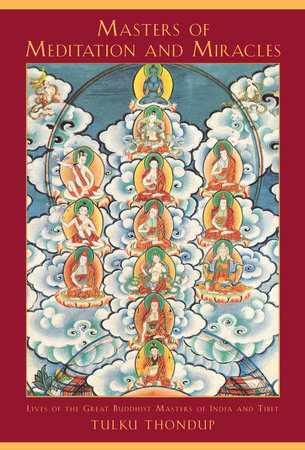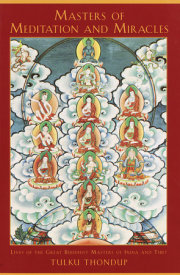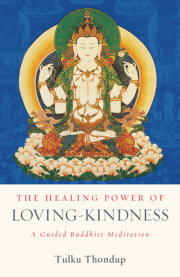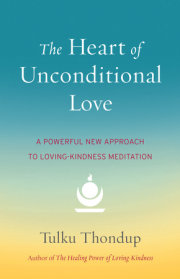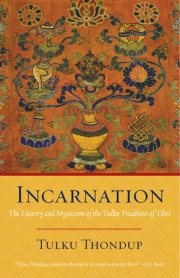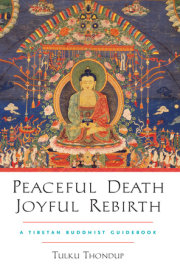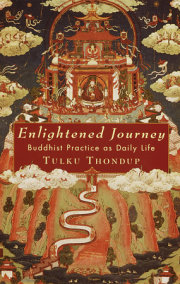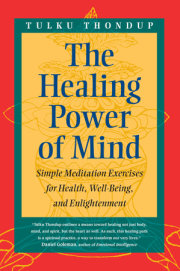Preface Masters of Meditation and Miracles is a collection of biographies of realized teachers whose lives were full of peace, enlightenment, and amazing miracles. They flourished in Tibet, the Roof of the World, in its golden days. These teachers belong to the Longchen Nyingthig lineage of the Nyingma school of Tibetan Buddhism.
Longchen Nyingthig (the heart-essence of infinite expanse, or the ultimate truth of the universal openness) is a cycle of mystical teachings that represent the innermost meditation of Dzogpa Chenpo, revealed by the great scholar and adept Jigme Lingpa (1730–1798). Jigme Lingpa discovered them as a “mind ter” (or “mind treasure”), teachings that were discovered from the enlightened nature of the mind. To Jigme Lingpa and then from him to the present, the transmission of Longchen Nyingthig was passed through the lineage of many enlightened masters, the most outstanding being the ones whose lives are presented in this book.
In the past, when I read the biographies that I have epitomized here, I saw them as most inspiring and amazing lives. But this time, as I was retelling them in my own words with my own feelings, I myself frequently underwent the experiences of pain, hardship, or excitement as well as peace, joy, light, or openness that the masters were going through. So the lives were no longer just stories to read or objects “out there” to think about. They were glimpses of the inner light of the masters, which is the “true nature” of the enlightened lives. In that “true nature,” all the different phases and expressions of lives are in communion, like rivers flowing into the ocean, a single body of water. If these biographies are read as stories with intellectual and emotional perceptions, the best possible benefit that could come is inspiration. If the lives are read in order to feel and unite with the experiences of the masters, the stories will certainly arouse spiritual realization, love, peace, openness, light, and healing in the reader’s heart.
It was improper and indeed impossible for me to try to avoid the typical characteristic of Tibetan biographies, namely the inclusion of endless lists of teachers, teachings, and disciples of the masters, even though those lists might be boring for readers who are not Tibetan. But I tried not to let these details diminish the vividness of the narrative. Wherever possible, I attempted to bring out the inner feelings of the spiritual lives, and at the same time the external daily lives, of the masters: how they faced and healed their physical pain, how they dealt with their emotional turmoil, how they overcame their spiritual or meditative illusions, and, more important, what kind of experiences they had when they awakened their own inner Buddha Mind and Buddha qualities.
This book has two parts. The first is an introduction providing a short life of the Buddha and a list of major lineages of Buddhism in Tibet. While basing the Buddha’s life on traditional scriptures, I have tried to present it in terms of its meaning and his teachings rather than as a historical narrative. For the list of lineages of Buddhism in Tibet, I have given a structural outline of some of the major ones, but few details of them or their teachings.
The second part is the main body of the book. It presents the principle of the three Buddha bodies and the biographies of thirty-five masters of the Longchen Nyingthig lineage.
The three Buddha bodies are Dharmakāya, the ultimate body, which is the total openness, the absolute nature of the Buddha; Sambhogakāya, the enjoyment body, which designates all the true Buddha forms that appear without subject-object duality; and Nirmāṇakāya, the manifested body, which is the forms of the Buddha perceived by ordinary beings. The three Buddha bodies are the sources of the ultimate teachings, such as Longchen Nyingthig.
The first master of the Longchen Nyingthig lineage in human form is Prahevajra (also known as Garab Dorje). The lives of the early human masters from Prahevajra down to Guru Rinpoche (9th century CE) have a unique quality. They were manifested as a higher power of discipline and attainments, possessing superhuman endowments and power. From Longchen Rabjam on, although the lives of these later masters reflect a path, dedication, and power different from our own, still they had many experiences that are similar to our own hardships, pain, and emotions, and we can imagine ourselves reaching the point when we would possess their capacity for dedication, healing, and realizations. Thus, the lives of the early masters are the most important ones, but for many readers the lives of the later masters might be easier to understand and empathize with.
It seems that there are two reasons for having these two types of biographies. Changes in the art of writing account for some of the differences between the accounts of early and later masters. But the main reason is the change of circumstances and gifts of the audience and their level of openness and appreciation.
Among the lives of the later masters, too, there are many, such as Do Khyentse, who were born with amazing wisdom and power, while others, such as the First Dodrupchen and Jigme Gyalwe Nyuku, accomplished the highest spiritual attainments through disciplines of austerity and dedication. Many masters often faced harsh obstructions in their spiritual journey, but the power of their understanding, commitment, and inspiration not only kept them on the path, but led them to their goals.
The Longchen Nyingthig transmission flowed through many masters of various lineages. In this book I was able to include only the main masters of the Longchen Nyingthig lineage itself and those masters who were directly involved in bringing the Longchen Nyingthig transmission to my teachers and then on to me.
Concerning the lives of many masters there is a vast literature, but for some important masters, Dola Jigme Kalzang, Gyalse Zhenphen Thaye, Khenpo Pema Dorje, the Second Dodrupchen, and Önpo Tendzin Norbu, I could find very little material. Also, I focused more on those masters about whom there is little material in English rather than on masters whose lives are already available in English.
The masters whose lives are chronicled in this book are some of the many rare individuals whom we had in Tibet during its more than ten-century-long history of Buddhism. One should not, however, get the impression that most of the Tibetans were great meditators and accomplished adepts displaying miraculous powers, as the novel Lost Horizon might portray! Such accomplished masters were very rare in Tibet in comparison with the population as a whole. At the same time, there is no reason to doubt that they were people of great spiritual power and realization. Where the circumstances were right and there was total dedication to the advancement of the spiritual quality of the mind rather than to material progress, such spiritual attainments were witnessed not just in Tibetan civilization, but in many cultures throughout the history of the world during the golden times of their spiritual wealth.
For me the material in this book was the most inspiring that I have ever worked on. Each master is totally different, yet they are very similar. Each great master has his or her own unique character to manifest, role to play, and place to fill in this golden lineage of Longchen Nyingthig. Most of these great masters have gone, disappeared into the distant past. But their presence in the golden lineage, their words of enlightening teachings, and their power of liberating blessings are still with us.
Copyright © 1999 by Tulku Thondup. All rights reserved. No part of this excerpt may be reproduced or reprinted without permission in writing from the publisher.

